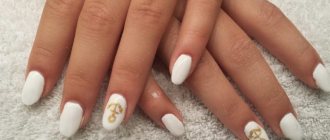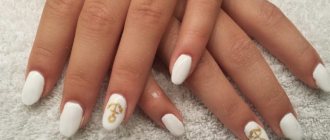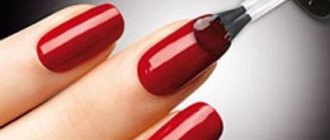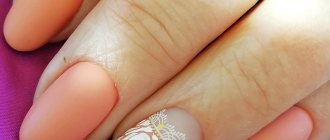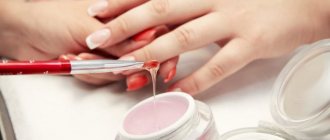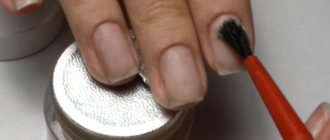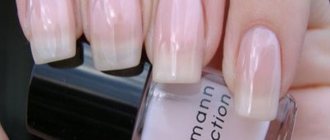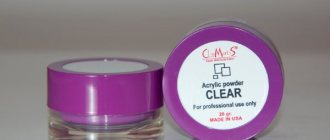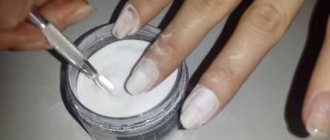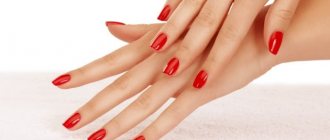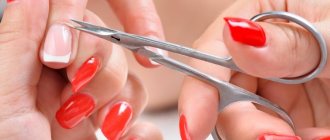The article contains information useful for women who want to make their hands beautiful and well-groomed. This is information about what acrylic is, how it has become an essential element of the beauty industry and why acrylic nail extensions are optimal, highly effective and suitable for almost any woman. It also explains why acrylic nails have a number of advantages over gel nails, how an acrylic manicure is done, what a French manicure is, how to apply acrylic nails at home and how to remove them.
History of acrylic use
In the 30s of the last century, the “father” of acrylic, polymethyl methacrylate, was developed in Germany. This is a durable, lightweight, transparent material designed to replace heavy, fragile and quickly heating glass. Polymethyl methacrylate has low thermal conductivity, it is durable, easy to process and remelt. The so-called plexiglass appeared; in Russia for many years it decorated the desktops of schoolchildren, students, scientists, and administrators.
In the 50s, acrylic was developed in the United States - a strong-smelling, colorless, transparent liquid obtained from natural gas production. It can be easily dissolved in ethers, chloroform and water. Acrylic is environmentally friendly, wear-resistant, cheap, practical, and can withstand temperature changes. Therefore, the new material was widely used and began to be in demand.
Today, acrylic bathtubs are popular, lightweight, easy to clean, comfortable, as well as acrylic coatings for cast iron bathtubs, hygienic and beautiful. Acrylic is used to make lampshades, display cases, suspended ceilings, and to make threads and fabrics called artificial wool. Several decades ago, almost all fillings and dental crowns in dentistry were made from acrylic.
Acrylic varnishes are widely used in industry. Postmodernist artists paint with bright and rich acrylic paints - impressionists would certainly appreciate them! Images on canvases painted with acrylic paints, unlike oil paintings, will never fade or fade. Acrylic can be used to paint wooden, glass, metal and plastic surfaces.
Acrylic has also found a place in the beauty industry: it is indispensable for nail extensions. Like all great inventions, acrylic nail coating was invented completely by accident. Its creator, dentist M. Lapp, tried to wean his wife from the habit of biting her nails. To do this, he covered her nails with the material from which he made dentures for his clients. Lapp's wife, who liked the updated nails, introduced a new fashion. Manicurists began using acrylic, purchasing it from dentists.
painting
Various designs are difficult to replicate with gel polishes. Acrylic paints are perfect for fragile and filigree drawing. They should have a thick creamy texture and rich color.
Before work you must:
- Degrease the nail and cover with base.
- Apply color and base.
- Remove the sticky layer and buff it so that the coating is matte and scratch-free.
- With a brush made of fine synthetic bristles, you can paint any patterns or elements.
Acrylic and gel nail extensions
In addition to acrylic, gel is used for nail extensions. Both of these materials are synthetic and have a lot in common. But a gel is a jelly made from a polymer using the right temperatures. And acrylic is a liquid and a fine powder; they are also obtained from a polymer, but using different temperatures and under different pressure. The liquid (monomer) is mixed with the powder, achieving a material with a liquid consistency, which hardens in a few seconds under the influence of oxygen.
Gel came into use later; it is a derivative of acrylic. Manicurists, having started working with acrylic and gradually changing technology, achieved a gel that hardened when exposed to sunlight. This simplified the technology: the gel is easier to apply; once on the nail, it immediately takes its shape. That's why some people prefer gel. But most masters still use acrylic.
Differences between acrylic and gel false nails
- Acrylic nail extensions are convenient because they correct imperfect (weak, broken) nails. Under acrylic coating, your own nails become stronger, grow, and take on a beautiful shape. If nails are extended with gel, then it is desirable that they are smooth and healthy: the gel does not hide obvious defects.
- Acrylic nails are stronger than gel nails and do not react to temperature changes. The gel does not withstand temperature changes. In cold weather, such nails can crack or break.
- Matte acrylic, glossy gel. Transparent and clear, like glass, the gel allows you to apply more complex and sophisticated painting to your nails. Acrylic helps create a three-dimensional design.
- When removing gel nails, you can only file them down. When sawing, tiny dust is released, which is harmful to health, constantly settling in the lungs. Of course, craftsmen are at greater risk than clients. Acrylic is removed using a special solution. Acetone can also remove it, but this is undesirable because it can turn your own nails yellow. True, the flexibility of acrylic to acetone does not allow you to immediately apply varnish to acrylic nails, because when removing the varnish from the nails, the acrylic will also come off. Those who love acrylic nails have to cover their nails with a special base. But acrylic nails don’t need to be varnished at all, they look so natural.
- Acrylic hardens on its own in a few seconds. In order for the gel to harden, a special ultraviolet lamp is used. When drying gel nails, there may be strong, albeit short-term, painful sensations.
- Sometimes they say that gel is healthier than acrylic (ultraviolet light, which is used to dry gel nails, protects your nails from fungus, under the gel layer the nails “breathe”), and that acrylic violates the integrity of the nail plates. These misconceptions are spread by craftsmen who do not know how to work with acrylic, the application of which requires greater skill. Gel is no healthier than acrylic, and acrylic is no more harmful than gel. Both materials have the same chemical composition.
Ideally, you should use both materials, covering acrylic nails with gel. Then your nails will be super strong and shiny.
Both acrylic and gel nails last up to four months. True, every two weeks you need to make adjustments (adjust the border between false nails and your own, change polish and designs) so that your nails continue to look natural.
Pros and cons of acrylic nail extensions
Like any technology, acrylic nail extensions have their advantages and disadvantages. The customer of the procedure needs to have an idea about them in order to choose what suits him best: acrylic or gel.
Advantages of acrylic technology:
- Exceptional strength compared to gel nails, the breakage of which under stress can injure your nails.
- The ability to correct your own nail and hide its flaws. Acrylic nails camouflage a small nail bed or an unattractive nail shape. Acrylic applied to the nail does not spread immediately, the nail can be “sculpted”.
- A French manicure done with acrylic looks more natural than one done with gel.
- Acrylic manicure, unlike gel manicure, can be made voluminous (the so-called 3D manicure).
- You can apply glitter in any quantity.
- Nails are easier to remove, can be treated with a special solution, and do not require filing with the release of harmful fine dust.
- Acrylic does not contain allergens.
Disadvantages of acrylic technology:
- It has an unpleasant pungent odor that irritates the nasopharynx. True, now manicurists use special extracts that soften the smell, but it is impossible to completely get rid of it.
- After removing the polish from acrylic nails, they appear yellowed. And if you remove acrylic with an acetone-containing solution, your own nails will turn yellow. Therefore, it is important to strictly follow the technology and not remove nails with an unrecommended product.
- It is impossible to achieve the ideal shine of nails, which is inherent in gel nails.
- Acrylic hardens very quickly, and after hardening, errors in the master’s work can only be filed away.
- It is difficult to find a good craftsman who is fluent in acrylic technology.
Strengthening nails with acrylic powder for gel polish
If you need to prepare for a manicure, it is better to use additional protection. The salon procedure lasts no longer than a quarter of an hour. Strengthening nails with acrylic is done without additional means. The work uses an antiseptic, primer, base and powder. Stages of the procedure:
- first, the master can perform a hand massage; it is not recommended to cut the cuticle, it is only pushed back with a bamboo stick;
- the nail plates are treated with an antiseptic and a special file;
- to improve the adhesion of the material to the surface, the plates are degreased;
- a primer is applied (a composition that acts as a primer), the layer is left to dry for several minutes;
- use a base base, then acrylic powder is poured on top to strengthen the nails;
- components are reused to improve performance;
- after which gel polish is applied.
Find out how to choose a sterilizer for instruments.
Price for strengthening nails with acrylic
Only good material should be applied, which will affect the cost of the coating. The price of the Chinese composition is more attractive, however, it will negatively affect the nail plates. For this reason, you should use inexpensive products with caution or avoid them altogether. The price of the procedure can vary significantly, depending on the salon, as well as the features of the technology. The table shows average prices:
| Procedure name | Price, rub. |
| Reinforcement using acrylic (without coating) | 1300 |
| Applying a protective layer under the varnish | 1600 |
| Removing the acrylic reinforcement coating | 550 |
- How to quickly cook beets
- Pork ribs in the oven - delicious recipes with photos. Baked pork ribs in the oven
- Staphylococcus aureus in the nose
The process of nail extension using acrylic
Nail extension with acrylic is a long and high-tech process. There are several steps to this process that must be followed.
Step-by-step acrylic nail extensions:
- Thorough hand washing.
- Preparing the nail for the procedure. The nail is treated with a special disinfectant that kills bacteria on the nails and protects against fungus.
- Getting rid of cuticles. The cuticle at the nail bed is pushed back with a pusher and then removed with tweezers or scissors.
- Processing and polishing the nail plate with a polisher, giving it evenness and smoothness. The smoother the nail, the better the adhesion to the acrylic mass.
- Degreasing, applying primer to the nail. This is required to dry the nail.
- Form overlay. A false nail form is put on the nail or a tip is glued. If you use a tip (a plastic base in the shape of a nail), then it is put on the nail while the primer dries. You may have to work with a special type cutter. With its help, the length of the nail plate is also adjusted. The acrylic is then applied inside the mold, applied to the plate and quickly hardens. After this, the tip is removed and the nail is given the desired look. If you use a form (made of paper or other suitable material), then you need to apply a primer so that the nail shines. Then put the form on the end of your finger, carefully bend it, being careful not to break or damage the nail. The form is pressed tightly, securing it in the center of the nail. After application to the mold, acrylic is distributed over the entire surface, and the mold is removed after the composition has dried.
- Preparation of acrylic composition. An acrylic brush is first dipped into liquid (monomer), then into powder.
- Applying acrylic to the nail. The ball, which is formed from liquid with powder, is carefully distributed over the entire nail. The coating is modeled before it has dried.
- Giving the nail shape. After the acrylic coating has dried, the ideal shape is created using a set of nail files. First, a large file is used, then smaller files for jewelry work.
- Oil treatment. You can polish the oiled nail again. This will completely level it, removing minor scratches.
- Covering the finished nail. For a glossy shine, the artificial nail is coated with gel.
The entire procedure takes from one and a half to four hours. The duration depends on the condition of the nails. Purchasing equipment for making acrylic nails is a special task for every master. The equipment with which you can achieve high quality is not cheap. An acrylic brush can cost 2-5 thousand rubles. Masters say that you should not skimp on brushes, as well as on other materials.
What is gel polish?
Coating your nails with gel polish promises you a glossy manicure for two weeks. If your nails are pretty good and you just want to give them a neater look, then you should opt for this particular coating. The procedure is no different from applying regular varnish; it just uses a special ultraviolet lamp for drying.
Advantages of the coating: shiny and glossy finish, no damage to the nail plate, no chemical odor, long-lasting effect and fast drying time.
Cons: negative effects of ultraviolet rays.
What is French acrylic manicure?
French manicure is a design option in which the protruding edge of the nail is highlighted in a different color. The tip of the nail, short and neat, is painted a bright white color, which naturally occurs only on the very healthy nails of very young women. The rest of the nail may be a soft pink.
Some argue that French nails were brought into fashion by the great Coco Chanel. Others say that the American Pinch. Originating in the 70s of the last century, French manicure continues to be popular. Probably due to the fact that “French” nails resemble natural, healthy and well-groomed ones.
French manicure is universal, it suits any dress, any lady’s style. And, of course, it makes her feel younger – almost like a schoolgirl.
In the 21st century, unlike the 20th, French manicure began to be done on long nails. There are also lovers of false “French” nails.
Now in every beauty salon where acrylic nails are made, you can see the word “French” in the first line of the manicurist’s price list.
Manicure with acrylic paints at home
Acrylic manicure is quite easy to do at home. To do this you need to have good brushes, files and other tools, as well as good lighting.
Acrylic dries quickly and does not require a special lamp for drying. This will allow any woman who knows the basics of manicure and is knowledgeable in the field of acrylic nail extensions to carry out the procedure herself with high quality.
It is important to free the brush from paint in time, without allowing it to dry, otherwise the brush will be destroyed and soaking it in a solvent will not restore it.
Special paints should be used for extended nails. It is desirable that they be water-based.
For home manicure, it is better to use tips rather than forms, since it is easier to grow nails with tips.
A set of good nail files (several, not just one) will allow you to polish your nails to an ideal surface, giving them a flawless look.
It is necessary to strictly observe the hygiene of the procedure at all stages (washing hands, thorough disinfection, degreasing), otherwise the nails will not take root: they will lag behind, forming sloppy pockets.
And, of course, it is important that no one distracts you while doing nail extensions. The phone should be turned off. If you have household members, it is worth warning them about your plans in advance. You should also ensure that they have their own set of keys and do not disturb you when coming or going, or enter your room during the entire procedure.
Acrylic in pedicure
Due to its strength, acrylic is also used in pedicures. There is a myth that strengthening nails with acrylic helps get rid of fungal infections. It is not true. The disease must be cured first. The polymer will only help fill in missing areas or hide unevenness.
Strengthening your nails with acrylic is a great opportunity to create a beautiful and long-lasting manicure yourself. This is especially true for girls whose nails are thin and break easily. The durable polymer coating will stay on your nails for up to a month.
Strengthening nails with acrylic, before and after photos
( 5 ratings, average: 5.00 out of 5)
How to remove acrylic paint from nails
Acrylic paint can only be removed with a special solution. This can be nail polish remover without acetone. This will remove the nail polish along with the acrylic coating.
You can also remove the acrylic coating with an acetone solution, but this is undesirable as it may turn natural nails yellow.
You cannot tear off artificial nails or rudely tear them off, even if they partially come off and form “pockets.” Your nails are seriously injured, and then you can’t apply acrylic or gel to them for a long time.
Even if you have good nail polish removers, it is advisable to have your acrylic nails done by a professional. Only a master will be able to do this correctly, without causing harm to real nails. The process of removing acrylic coating can be long, labor-intensive and require a lot of solvent.
How to choose the right acrylic nail polish?
Convenient organizer for storing varnishes
Recently in our country people have become more concerned about the environment and their health. They also pay attention to their nails, trying to purchase the highest quality varnish. But making the right choice of nail polish among a whole variety of tiny bottles can sometimes be very difficult.
When choosing a high-quality nail polish, first of all you should pay attention to its price category. Cheap polish may turn out to be a fake, expired product and will only cause harm to your nails. But you shouldn’t chase the most expensive acrylic varnish either, because most often in terms of its quality it is in no way inferior to varnishes of the average price category. The most affordable in terms of price, quality and availability in the store can be considered acrylic varnish from the American manufacturer Sally Hansen.
The shape of the bottle and brush plays an important role in choosing acrylic nail polish.
The bottle of varnish should be straight and elongated, and the brush should have even bristles that stick together and do not stick out in all directions. The bristles of the brush should be stiff, and their tips should not touch the bottom of the bottle. In addition, before purchasing, you can try to paint one nail for yourself - in this case, the bristles of the brush should make a neat semicircle.
And finally, you should definitely look at the composition of the product. Acrylic varnish with castor oil or dibutyl phthalate is impervious to sunlight, and the presence of butyl alcohol and formaldehyde resin adds viscosity and shine; there are also products with calcium, which strengthens nails.
So, when you go to the store, you should first of all pay attention to the price of acrylic nail polish, the bottle and brush, as well as its composition, and then the chosen product will make your manicure neat and beautiful.
What are the possible contraindications?
Since sharp-smelling acrylic is not a highly toxic substance, it will not cause negative health effects. However, there are contraindications, or factors that can reduce the effectiveness of the extension procedure. There will be no harm, but detachments will occur and the nails will not “take root.” Contraindications for acrylic nail extensions:
- Diabetes mellitus, coronary heart disease and other cardiovascular diseases, cirrhosis of the liver - this is a list of the main diseases that can cause artificial nails to peel off, forming pockets.
- Pregnancy.
- A course of treatment with antibiotics, or in more severe cases, chemotherapy. If treatment is started after the nails have been done, this does not mean that they will immediately fall off, but peeling is possible.
- Allergies, individual intolerance to acrylic. Although rare, there are clients who react acutely to volatile chemicals. As a rule, they are aware of their peculiarities and do not extend their nails with acrylic.
- Skin diseases, herpes (with rashes on hands).
- Fungal diseases, viral and bacterial infections of the nails and skin around them.
- Traumatic lesions of the nails, panaritium or hematoma under the nail, as well as serious injuries to the nails after artisanal removal of the nail covering.
Acrylic nail extensions in themselves do not harm clients. Acrylic is recommended for all women who want to achieve beauty and well-groomed hands.
Acrylic composition
Initially, the basis for strengthening natural nails with acrylic was methyl methacrylate. This material turned out to be insufficiently elastic. The nails became brittle and thick and did not hold their shape well. In addition, it is toxic. Methyl methacrylate negatively affected the condition of the nails and overall well-being. Therefore, now the substance is practically not used in the beauty industry.
It was replaced by ethyl methacrylate, an ethyl ester of methacrylic acid. It is practically odorless and does not have such a negative effect on the nervous system, kidneys and liver as its predecessor. Since the name of the substance is quite complex, it began to be called simply acrylic.
